Among the types of laying electrical wires inside residential premises, the method of their open arrangement on building structures is the oldest, time-tested.
Technically, this installation method can be carried out:
1. stationary fastening of wires;
2. temporary placement of portable cables - extension cords.
Carrying is a backup method for short-term connection of individual electrical appliances. It is not recommended to use them constantly. Load currents completely pass through them, and the entire structure is subjected to periodic mechanical stress that can cause damage. Extension cords with portable cables require frequent inspection.
Open wiring has three characteristic features:
1. visible to any visitor and therefore should be beautiful and attractive;
2. exposed to sun rays, capable of destroying a layer of insulation that is not resistant to it over time;
3. less protected than other types from accidental mechanical impact.
Existing modern methods open routing of wires takes into account all these three factors, allowing you to create exclusive design rooms in a retro style, which is loved by many owners of private houses, dachas and cottages, and to give them a different look.
This method is especially suitable for elite wooden buildings made of rounded or laminated timber, when it is necessary to preserve the integrity of the wall structure and show their decorative texture.
It is also used for additional installation conductive lines in the case when finishing work has already been completed in the room, created unique interior, which should be saved.
Types of fixed open wiring
Wires are attached to building elements various methods. Practical use Nowadays there are five ways:
1. cable laying with fastening with brackets;
2. retro style on casters made of porcelain RSH-4;
3. plastic channel boxes;
4. corrugated pipe made of metal hose with plastic corrugation;
5. European skirting boards.
All plastic products for installation they must be fire-resistant and not support combustion.
Laying cables on walls and ceilings
In open wiring, it is allowed to use cables with light-resistant insulation, for example, grades APPV (with aluminum core) or PPV (copper). It's best to technical specifications cable marked VVGng-LS is suitable due to the fire-fighting properties of its insulation:
does not support combustion;
has reduced smoke emission.
Since overheating of the wiring may occur when the network is overloaded, the heat generated from it should not be transferred to building structures. When placing the cable on wooden surface Asbestos tape is placed under it and secured in one of the following ways:
metal brackets with gaskets to the base;
tin strips with buckles;
ribbon with buttons;
bandage strips;
plastic mounting clamps.
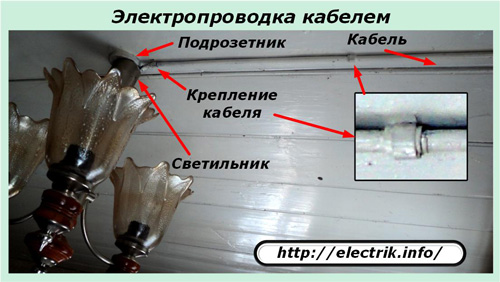
Cable routing open method It is rarely used inside residential premises: it greatly complicates the creation original look rooms, giving them a formal, office look. This method is better suited for technical rooms.
Switches, sockets and lamps are mounted using socket boxes, which may have decorative form and colors. They are impregnated with a special solution that provides fire-fighting properties.

A metal plate is also installed between the wall and the socket box to prevent the spread of fire. This mandatory rule must be combined with the designer’s ideas.
Retro-style wiring on porcelain rollers RSH-4
Beautiful stranded flexible wires for these purposes are created with two layers of insulation. Her inner part provides protection against voltage potential, and the outer one, made of silk lining, is impregnated with a layer of varnish and reliably protects the insides from solar radiation.
The total cross-section of the core is selected according to the current load, but usually 2.5 mm2 is used.
The wires are held on rollers by laying with a uniform pitch and tension, and are spaced from the building structure with a sufficient air gap, controlled visually.

Wiring in plastic cable channels
The electrical cable and wires are laid openly and, at the same time, hidden from human eyes, which are selected by color and dimensions.

The cable channel can be attached to the wall with self-tapping screws or simply glued. In the second case, it is necessary to pay attention to preparing a smooth and level surface for installing the box.
When installing it in this way, first coat it with glue reverse side cable channel and press it to the marking site to transfer part of the glue there. Then the box is immediately removed from the wall for a few minutes, waiting for the adhesive sides to harden. After this, they are pressed tightly for quick, reliable gluing.
When fixing the box in drywall, use a butterfly dowel. At the junctions components and in places where they turn they are used additional accessories: plugs, corners, adapters, connectors. They should fit together easily and cover gaps that are visible to the eye well.
Wiring in decorative metal pipes
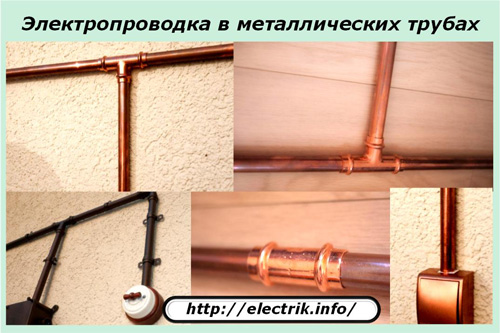
This method was originally created to work electrical systems inside technical premises with an increased risk of fire or explosion. The wires and their connections were completely contained in a sealed housing created by pipes made of steel, aluminum or copper alloys.
Such wiring is most protected from influence environment and separated from it. Pipes of standard length are assembled into the main line by couplings and adapters, turns are created smoothly with special 90-degree angles.
During assembly, welding is not used, all work is performed hand tools. The technology allows you to change the network configuration if necessary without much labor.
Application decorative coatings for copper and brass pipes made it possible to use this method for laying open electrical wiring in everyday life, creating Beautiful design, emphasizing the antique interior in combination with bronze and copper lamps.
Corrugated wiring
This method of open wiring is considered one of the simplest. It is common, popular, but fits better outside electrical networks located on building surfaces outside residential premises. Appearance Corrugations are difficult to combine with the design of living rooms.
The corrugation is well suited for attics, basements, garages: those places where you need to quickly lay wires, protecting them with an additional plastic casing. By selecting the diameter of the corrugation, you can create highways for placing several parallel cables in one pipe.
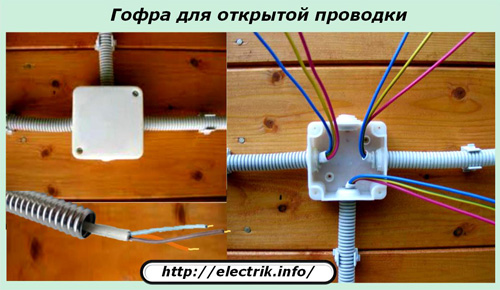
Another feature of this method is the need to pass a prepared cable or wires through it before fixing the corrugation to the wall, which presents certain difficulties.
To do this, use an intermediate element - a cable or wire, which is inserted inside the corrugated tube in advance. Then one end of it is fixed, tied to some support or held with pliers, and the other is attached to a cable or wires inserted inside the corrugation. To facilitate installation, they must be pressed tightly to create a reserve of space between their surface and the corrugation.
The wire is maintained in a taut position and the wires are carefully inserted into the corrugation.

Wiring in decorative skirting boards
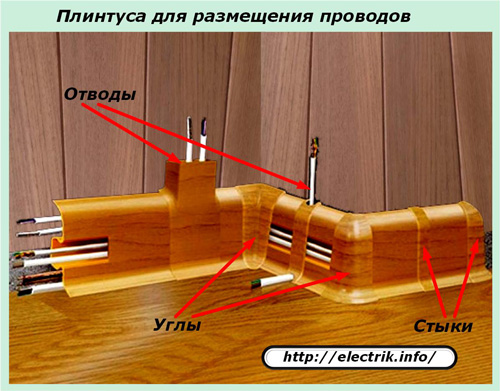
Using a floor or ceiling plinth allows you to hide and disguise traces of electrical wiring and at the same time conveniently place it in prepared decorative gutters.
5. Installation checks and measurements electrical characteristics
This important stage it must be carried out not independently, but with the involvement of specialists from an electrical laboratory who check the quality of installation of the circuit not only visually, but also by performing electrical measurements and tests, which makes it possible to provide a guarantee of its performance.
During the inspections, it is necessary to identify:
the state of the insulation resistance of the wiring in the assembled circuit;
download all circuit breakers power circuit;
check leakage currents for installed RCDs and difavtomatov;
evaluate the health of other specific circuit elements.
For all points of the measurements performed, you will be given protocols with a conclusion on the suitability of the equipment for work. Only after that it is allowed to apply voltage to it.
6. Engagement in work
Independent commissioning of equipment without testing and measuring it can lead to power failures, fire, and electrical injuries. The prerequisites for their occurrence can only be eliminated by measuring the electrical characteristics of the network from external sources.
Therefore, the first switching on of newly installed open electrical wiring must be trusted to specialists who have the appropriate measuring and testing equipment and experience in its use.
First, let's figure out what internal wiring is. This is, simply put, all the wires and cables with fasteners through which current flows in your home.
There are several types of wiring
- passes over the surface of ceilings, walls or other parts of the building.
- Hidden wiring is laid inside walls or other elements of buildings.
- External electrical wiring is laid along the outer parts of buildings. It can also be either open or hidden.
We've sorted out the types of wiring, now let's proceed directly to the installation of internal electrical wiring. And so, depending on its type, they produce different stages construction sites
Closed wiring
Closed wiring should only be installed before all finishing works, since if the room has already been finished, additional costs will be required for re-finishing. Mounted in parts between distribution boxes. The wires are laid in pre-made grooves (grooves) and then plastered.
Installation of open wiring
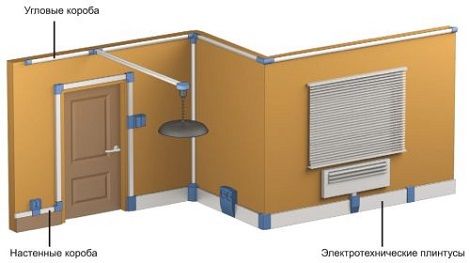
Produced after finishing work. The wires are secured with tin clamps, porcelain insulators or special fastenings made of plastic which are installed every half meter. If the walls consist of flammable materials, then passing through them, the wires must be laid in metal or plastic pipes.
Preparation
Before you pick up a tool, you need to carefully calculate everything and draw up a plan diagram. Switches are located close to doorways. If the wiring runs in unheated or damp rooms, then you need to use wires in a special sheath, or put them in metal pipes.
When drawing up a plan, it is calculated required length cable. The wire is taken with a margin of 10-15 centimeters at the ends so that switches, lamps, sockets can then be connected and twisted together in junction boxes. It is recommended to save the plan diagram, as you may need to repair the wiring or simply know where the wires go if you need to hammer a nail into the wall.
Electrical wiring installation
The cable must be laid strictly vertically or horizontally. On turns and bends it should pass at 90 degrees. If it intersects with metal parts, it is necessary to strengthen the insulation. You can strengthen the insulation by simply winding several turns of electrical tape at the point of contact with the metal.
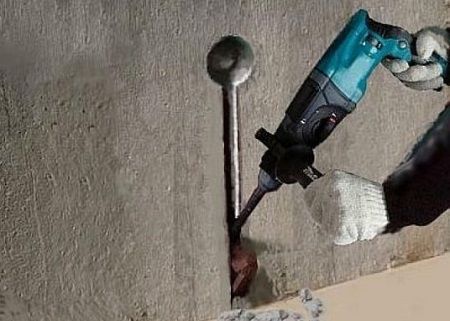
We punch grooves (grooves) using a wall chaser, a hammer drill, or, in the absence of either, simply with a chisel and a hammer. If the walls are wooden, then sheet asbestos is placed under the wire.
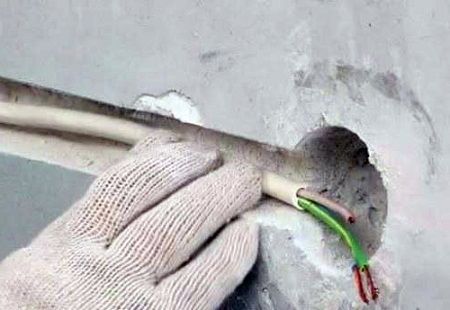
Worth paying Special attention The fact is that the wire, even if it is flat, cannot be fastened with nails. We even insulate the unpowered ends, and after the walls are plastered, the ends are connected to each other or connected to switches and sockets. Aluminum wires only need to be soldered together, but for copper both soldering and twisting are suitable. In sockets, switches and lamps, we clamp the stripped ends with screws in the terminals.
Hello, dear readers and guests of the Electrician's Notes website.
In the last article we learned about what electrical wiring exists, as well as their advantages and disadvantages. Today I will tell you about the features of installing open electrical wiring.
Open electrical wiring is laid openly on walls, ceilings and other building structures, rather than inside them. IN given time It is used extremely rarely, but it is one of the simplest laying methods.
Before you begin installing exposed electrical wiring with your own hands, read my following articles:
Advantages of open wiring:
- quick access to monitoring the condition of electrical wiring and its repair
- used in fire hazardous areas (or)
Disadvantages of open wiring:
- located in a prominent place
- does not match the decoration of the room and design
Several methods are used for attaching cables and wires to surfaces:
- on porcelain rollers or insulators (this was usually how electrical wiring was done in old apartments and houses)
- on staples
- in a corrugated pipe (metal hose and plastic corrugation)
- in plastic boxes (cable channel)
- on cable trays
- European skirting boards
Let's look at each fastening method in more detail.
Installation of exposed electrical wiring on porcelain rollers or insulators
At the beginning of the last century, this method of laying electrical wiring was used in old apartments and houses. Open electrical wiring was laid on porcelain (ceramic) rollers or insulators with twisted wire.
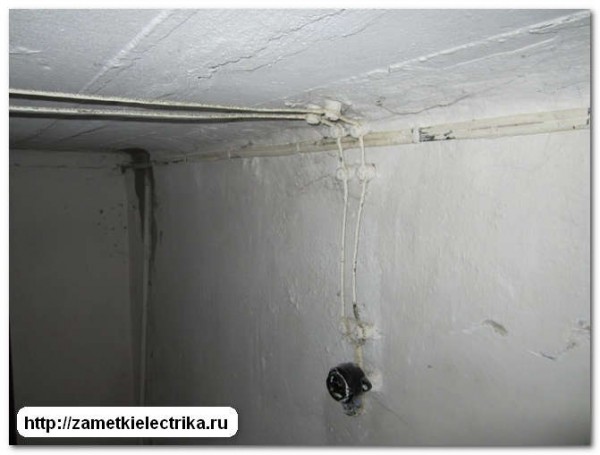
Currently, this laying method is again gaining popularity, especially for lovers of retro style design. This retro installation will give your apartment or house an individual, special style.

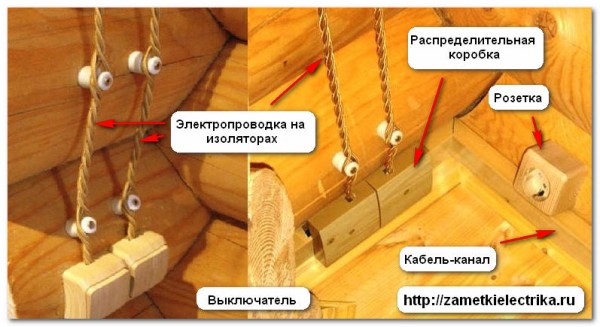
I also want to say about the disadvantages of this method.
Firstly, there is the cost of purchasing stranded copper wire and it is desirable that it be double insulated. For example, a PVOp or GPOP wire of the appropriate sections is suitable for these purposes. True, its price is several times higher than that of the familiar VVGng.
Secondly, you will also have to spend money on purchasing expensive special accessories for retro style: ceramic rollers, sockets, switches, distribution boxes and so on.
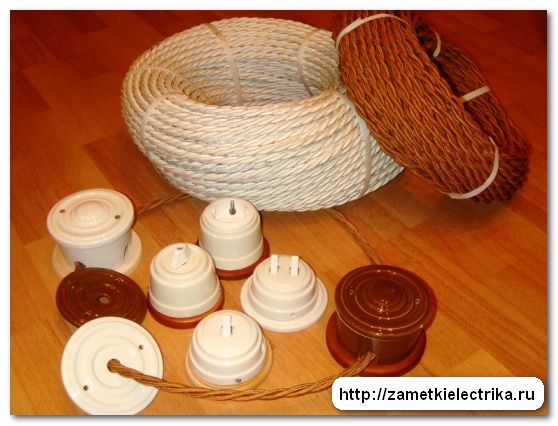
Installation of exposed electrical wiring on brackets
Using this method, wires and cables are fastened with special plastic staples to the surface of the wall or ceiling. Most often, cables with double insulation of the VVGng brand (single-core copper, flame retardant) and triple insulation of the NYM brand are used.
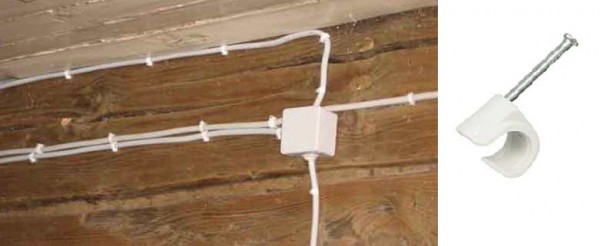
If you use electrical wiring (universal flat wire) for installation, then you need to lay a metal or asbestos gasket between the surface and the wire. Moreover, the gasket should protrude 1 cm on each side of the wire.
Installing open electrical wiring on brackets is one of the cheapest installation methods, but it has one significant drawback - it is unaesthetic, especially when laying several cables in parallel.
The method of laying cables and wires in a corrugated pipe (corrugation) is the most common. One or more cables (wires) are pulled into the corrugation and secured to the surface using plastic clips or metal staples.
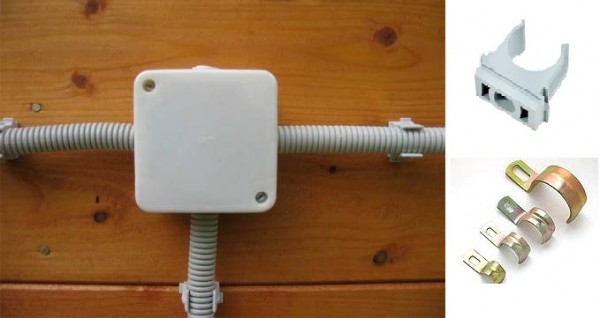
Corrugated pipes are non-flammable materials (do not support combustion), and they also provide additional mechanical protection.
Let me give you an example of a gasket. The PVC corrugation is attached to the ceiling using plastic clips.

And here is an example of fastening corrugations using metal brackets.
![]()
From an aesthetic point of view, a corrugated pipe looks much better than a separate cable or wire on brackets. And also the corrugation fits perfectly on uneven surfaces.
Installation of open electrical wiring in cable ducts and plastic skirting boards
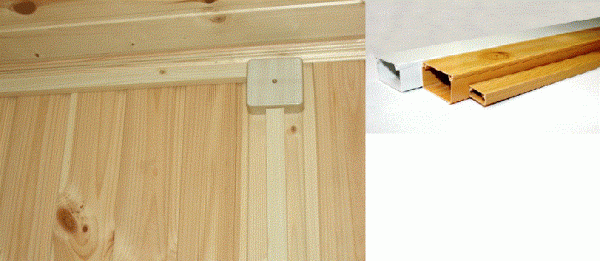
Plastic boxes (cable - channels) that do not support combustion are pre-attached to the surfaces of walls and ceilings. After attaching them, wires and cables are laid in them and closed with a lid. Installation of cable channels requires special skills and experience, because... The difficulty lies in installing them on uneven surfaces.

The advantage of cable channels is fast and easy replacement electrical wiring, as well as aesthetics, fittings and colors that allow you to match them to the color of the design and interior.
An analogue of cable channels are plastic European skirting boards. They are attached to the wall surface using clips or dowel nails.
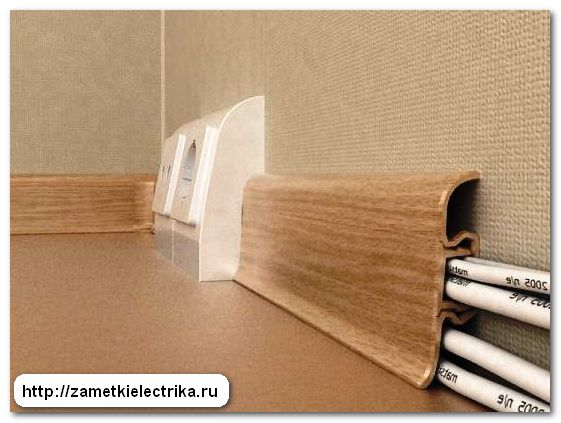
P.S. Concluding the article about open wiring, I would like to note that in electrical installation conditions sometimes it is necessary to combine some of the listed methods of laying electrical wiring along different things reasons.
One of two options for installing electrical wiring in a country house - open or closed - is chosen with reason. Having trouble with your arguments? And we will tell you!
IN wooden walls it is cheaper and easier to comply with safety rules when laying electrical communications in an open way (although under certain conditions it is possible to install closed wiring). Today it is no longer necessary to distance cables from the walls by 2 cm, hanging them on ceramic insulators. They are attached with plastic clips directly to wooden crowns or placed in overhead cable channels.
In a stone cottage, closed wiring is undoubtedly more convenient. It is insulated from accidental damage, does not interfere with the arrangement of furniture and does not conflict with the style of the interior. However, if you prefer a retro setting or don’t want to ditch the walls, then open wiring will provide support.
Closed wiring
Closed wiring is an important component of home life support systems. In stone buildings it is installed at the final stage of construction, before finishing work begins. Channels are hollowed out in the walls, drawn into them and fixed in corrugated pipes cables, make recesses for mounting boxes.
The laying of canals does not tolerate chaos. Just imagine the consequences of hardware getting into the cable when trying to “drive a nail” into the wall! For this reason, experienced electricians lay wires strictly horizontally or vertically from sockets and switches. If the wiring is placed in the floor, laying is done around the perimeter of the room at a distance of 10 cm from the walls, and the cable does not interfere with the fastening of the baseboard.
IN wooden houses closed wiring is laid during the construction phase. It turns out that at this stage it is already necessary to have a design project that shows which electrical appliances will be located in the house and where.
✓ Please note
When installing electricity into a house or changing wiring, it is dangerous to skimp on equipment and installation. It is better to entrust the selection of cables, protective modules, as well as sockets and switches to a specialist who will take into account all the nuances.
The issue of safety, especially when wiring in a wooden house, should come first. In this case, it is wrong to focus only on price; it is not an absolute indicator of quality. If for one reason or another the choice falls on retro-style sockets and switches for open wiring, you need to understand that in terms of technology and safety they are not inferior to other modern equipment.
Open wiring
Walled up in a stone wall electrical wiring doesn't represent much fire danger. Of course, an outlet may spark or a faulty electrical appliance may catch fire, but that, as they say, is a completely different story.
In wooden houses, a short circuit or other failure in the electrical network may well cause a fire. Meanwhile, hidden wiring in a country house often becomes the object of attention of rodents. In addition, 8 voids wooden houses where the wiring is laid, wood dust accumulates, which instantly ignites from a spark. Therefore, in accordance with the current Russian standards, electrical wiring on a combustible base is carried out openly.
The advantages of open wiring are obvious. It is easy to install, maintain and control; if necessary, the track can be moved, supplemented or repaired. There are also “cons”. An open installation method eats up part of the space: you can’t hang a shelf over the cable, sometimes you can’t put the cabinet close to the wall.
Open wiring – retro + progress
Traditionally, open wiring was arranged with twisted wire on ceramic insulators. This is the way today. most suitable for retro style, easy to repeat using modern twisted three- or two-core wire and ceramic holders. Styling will cost more than open wiring from a conventional cable on plastic or metal brackets. But in any case, the step between the holders should be no more than 50 cm, and in difficult areas they are placed more often.
To protect open wiring from a conventional cable from accidental damage, cable channels and plastic skirting boards are used. Their internal space may have partitions that allow you to lay inside the boxes at the same time both low-current and power cables. The removable upper part provides the possibility of monitoring the condition of the track and its modernization.
✓Note
The protective ground in the three-core cable must be connected to a galvanized steel ground loop buried in the ground near the house. The lightning protection system is also connected to the grounding loop. In general, this is a separate independent project that takes into account the properties of the soil, the occurrence groundwater, meteorological features of the region.
Electrical wiring begins with a project
Electricity supply country house should be carried out according to a project carried out in a specialized organization that has official permission and approved by the Rosenergonadzor authorities. But before ordering a project, you need to draw up technical specifications. To do this, you will need to obtain information about the power allocated to an apartment or house (a certificate is issued by the operating company), draw a diagram of the location of sockets, switches and lighting fixtures(or order a design project), and also calculate the expected electricity consumers. The power supply system installed according to the project is tested, after which it is accepted into operation by an Energonadzor inspector. Only this approach guarantees electrical and fire safety Houses. In practice, an electrical project is often carried out by an architect-developer of the general construction part, or even a designer, who does not have not only the appropriate permits, but also the proper knowledge.
Protection against electric shock
Circuit breakers protect the electrical network from overloads, including short circuits. Residual current devices or RCDs are disconnected electrical circuit in case of current leakage, which may occur due to various reasons. For example, due to aging insulation or mechanical damage cable. In addition, the RCD de-energizes the network in the event of a fire.
Modern differential circuit breakers perform two functions at once: RCDs and circuit breakers.
And if the electrical wiring is installed correctly, then 8 emergency situation protective devices will de-energize the network, preventing human injury electric shock and home fire. If the power allocated to the house is not enough to simultaneously turn on all the necessary household appliances and heating devices, it is recommended to install a load limiting relay. A smart device will prioritize. For example, when a powerful vacuum cleaner or electric grill is running, the heated floors are temporarily turned off.
✓ Need to know
Natural shrinkage of 3 cm of a typical 2-storey house in the first years after construction will lead to squeezing and cracking of cable channels. The wiring will have to be redone!
Installation of panels
According to the instructions of Energonadzor, in country houses two switchboards should be installed: one outside the house, the other inside. An external one is needed for an electric meter so that regulatory authorities can check the readings at any time. The internal panel is used for installing electrical modules.
On its mounting profiles or DIN rails, an introductory switch and differential automata are located. Each of them is responsible for a specific group. Let's say one is for lighting, the other is for sockets.
Except protective devices there is also room for auxiliary modules: load limiting relays, relays that monitor the quality of incoming electricity.
The distribution board is selected in such a way that after assembly there remains at least 30% of free space, because over time the needs for power supply may increase. In wooden houses, mounted dust- and moisture-proof power panels with an impact-resistant lid that is locked with a lock are installed. In stone, as well as in city, apartments, built-in wardrobes are usually used.
✓Expert opinion
If the customer voices the task of gradually replacing the wiring in the house, then at the design stage of the distribution board it is noted which groups of consumers should be connected to the power supply at the first, and which at the second (final) stage. This is taken into account in the single-line switchboard diagram: some consumers will connect to the home’s power supply system, and for others, backup outgoing lines will be provided in the switchboard.
Then in the future it will be possible to complete the wiring and connect new groups of consumers through the “backup” lines of the input panel. But we do not recommend dividing the work of replacing electrical wiring into stages. At a minimum, shields must be installed throughout the entire house and power cables must be installed.
Electrical wiring installed at home may be open or closed. If we talk about open wiring, it is performed as follows.
Open wiring
The wiring is carried out along the wall, in plastic pipe , in a special cable plinth, in a special cable plastic channel. As for the height of the open laying of the protected cable and wire, the descents and ascents of such laying to the shields, switches, starting devices and lamps that are installed on the walls, they are not standardized. When performing open electrical wiring in the cable plinth and channel, the wires of power, lighting and low-current types do not mix with each other. Fixation of the plinth or channel should ensure its sufficiently tight fit to the building foundations, as well as provide a gap between the plinth and the floor or the channel and the wall covering - no more than two millimeters. Skirting boards with channels must be purchased from fireproof, as well as self-extinguishing materials that have electrical insulating characteristics. Modules of a cable channel, a cable plinth in a residential building can be used if a flexible layout of the installation of fixtures, as well as lighting control devices, is provided. Such devices allow you to change wiring layouts and place electrical equipment, sockets and switches in different ways. In basements that are not heated, in closets and attics, in rooms that are built from wooden structures, electrical wiring is performed in an open manner using brackets.
Closed wiring
But you can do the wiring in a hidden way - in cavities building structures , above hanging ceiling coverings, in prefabricated partitions, in grooves that are made in wall coverings, in monolithic pipes. Horizontal places of power cable distributions are laid in floor covering, which is made of non-combustible materials, such as “warm floors”.
The processes of laying wiring under the plaster layer, in partitions, in the cavities of building structures
If you decide to lay the wiring of lighting networks embedded in the furrows of wall coverings, partitions, ceilings, under plaster or in the cavities of building structures, then it is recommended to use insulated cables or wires in a common protective sheath that provides mechanical protection. If it is necessary to dismantle such a gasket, it is necessary to make repairs almost anew. Therefore, before choosing this method, you need to do a good calculation.








